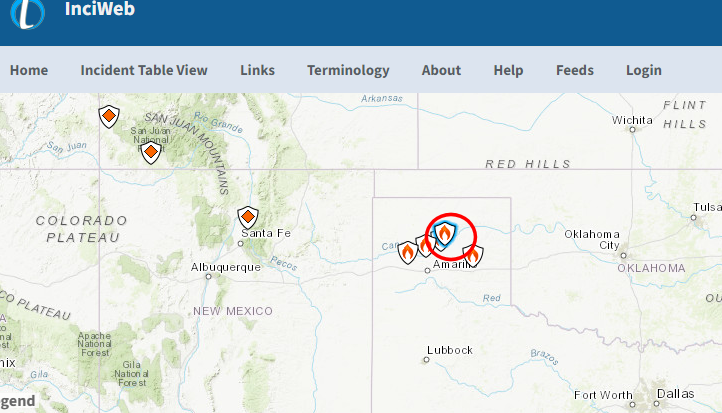Heads Up Media – Texas Wildfires Have Nothing to Do with Climate Change
A few days ago, a wildfire started in north Texas and grew quickly, driven by strong southwesterly winds. Named the Smokehouse Creek Fire, it has burned more than 1.1 million acres and is now the largest wildfire in Texas history. The mainstream media has been quick to blame climate change for the fire, with headlines like this one from NBC News: Wildfires ravage Texas amidst climate change crisis, or this one from ABC13 in Houston: How climate change is increasing wildfire risks across Texas. These stories are false; multiple lines of real-world data refute any connection between these fires and climate change.
NBC News claims:
The Texas Panhandle is no stranger to face-blasting winds nor roller-coaster dips in temperature. But the fires would not have had the same chance to take off if not for unseasonably warm temperatures and dry conditions made more likely by climate change.
ABC13 claims:
Additionally, climate change could increase Texan’s risks for wildfires over the next 30 years. ABC13 Meteorologist Elyse Smith has previously covered this topic through ABC’s Weathering Tomorrow initiative, which uses data from our partners at the First Street Foundation. It shows how wildfire risk, as well as heat, flood, and wind risks, will be impacted by climate change through the year 2050.
If either of these news outlets had bothered to do a ‘fact check,’ they would find their claims are unsupported by real world data.
Data from the National Oceanic and Atmospheric Administration for Texas show that the state has experienced a declining trend in number of very hot days and a slight increase in precipitation (see Figures 1 and 2, below).
Figure 1 – From 1910 through 1964 the number of hot days was actually greater than the current period of time.
Figure 2 – From 1970 to the present, average annual precipitation for Texas increased.
With fewer hot days and increased precipitation recorded in the long-term climate records, the claim that Texas is more susceptible to wildfires now that in the past because of climate change is clearly false.
Both media outlets suggested that the area where the fires are is drier than normal. This too is false. Here is a map from InciWeb showing the location of the Smokehouse Creek Fire (circled in red) in Figure 3.
Figure 3 – location of the Smokehouse Creek Fire.
According to the US drought monitor, the area now beset by the wildfire is not abnormally dry and certainly not experiencing drought conditions:
Figure 4 – U.S. Drought Monitor map of Texas for Feb27, 2024. Note most of the upper Texas panhandle area is not in drought.
Nor is the adjacent region of Oklahoma caught up in the wildfire suffering under abnormally dry or drought conditions.
According to Climate at a Glance: U.S. Wildfires:
Wildfires, especially in arid parts of the United States, have always been a natural part of the environment, and they likely always will. Global warming did not create wildfires. In fact, wildfires have become less frequent and less severe in recent decades. One of the key contributing factors has been that the United States has experienced fewer droughts in recent decades than in periods throughout the twentieth century.
According to the National Park Service, wildfires in Texas have always been a part of the state’s history. However recently invasive species now cover much of the region. According to the Texas A&M Forest Service:
Invasive species cause many negative impacts to the Texas landscape, from the displacement of native trees to potentially wiping out entire species.
Much of the Texas panhandle region is overgrown with cedar, acacia and invasive mesquite trees which use up a lot of groundwater. Previously, natural fires in the region helped control the spread of this problem, but with modern fire suppression, fuel loads have increased.
Even the most recent International Panel on Climate Change (IPCC) assessment of global climate agrees. On Page 90 – Chapter 12 of the UN IPCC Sixth Assessment Report. Emergence of Climate Impact Drivers (CIDs) the table in Figure 5 shows the incidence of “Fire weather” has not emerged from climate change:
Figure 5: note that Fire Weather has not emerged from climate change being a driver.
Finally, recent satellite data show no correlation between wildfire acreage burned and carbon dioxide levels. In fact, global wildfire area burned declined substantially between 2000 to 2018, even as carbon dioxide levels increased. If climate change was driving an increase in wildfires you would see it in the global data, but it shows just the opposite.
Actual data and various lines of hard evidence show that there is no connection between climate change and the wildfires now ravaging parts of north Texas and Oklahoma, or anywhere else for that matter. Sadly, once again the media is pushing the “climate catastrophe,” narrative in which every extreme weather event or natural disaster is caused by climate change, despite the clear evidence that this is false. In this case, rather than doing investigative due diligence, neither NBC nor ABC bothered to check facts before publishing these scare stories, which suggests that their reporters and editors are either lazy, incompetent, blinded by political ideology, or all three.








